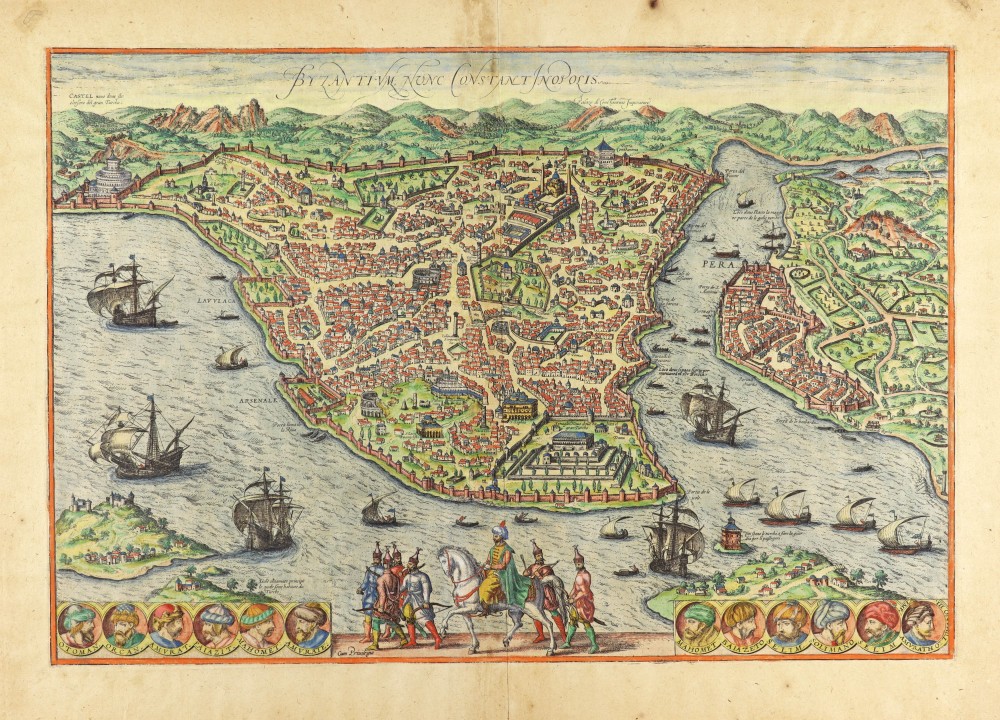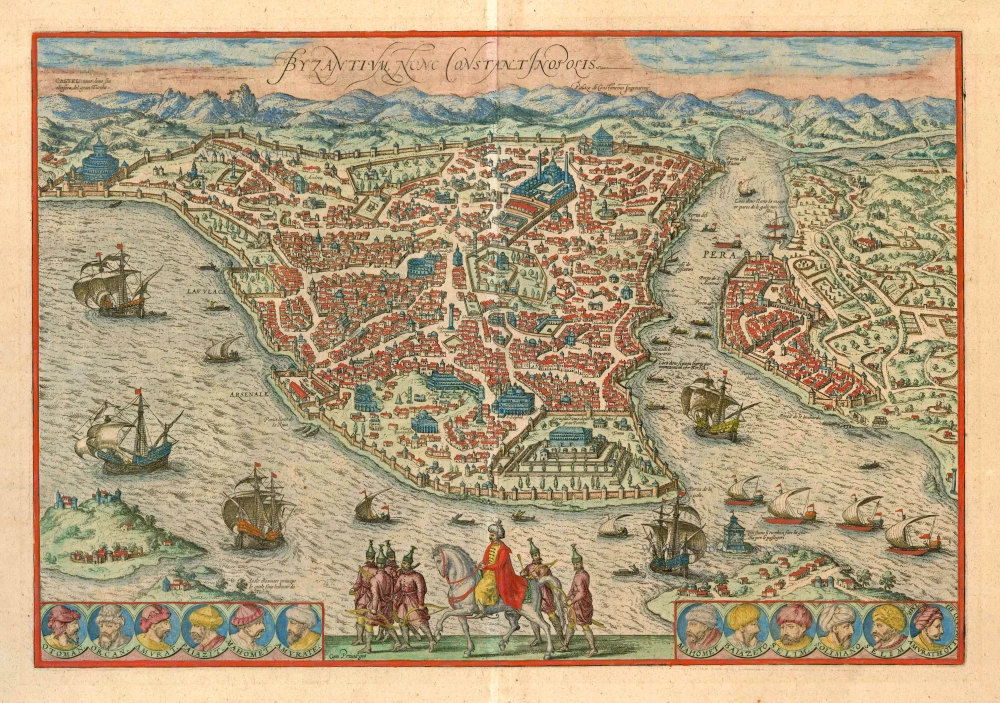Antique old map - bird's-eye view of Constantinople (Istanbul) by Braun and Hogenberg 1612
The city view includes the monuments of Saint Sophia and Topkapi Palace. Twelve vignettes of Ottoman sultans line the bottom margin, including portraits of Soliman the Magnificent and Selim. Numerous ships in Bosphorus and Golden Horn. Mounted Sultan with entourage at bottom centre.
CAPTION: Byzanz, now Constantinople.
COMMENTARY BY BRAUN: "Byzantium is a central place because no one can travel to Asia or Europe without the city's consent since the city is like a bridge or a gate for one part of the world. The sea binds it on three sides: to the north, the arm of the Bosporus, which belongs to Europe and is called Cornus (Horn). To the east is the Bosporus Strait; to the south is the Sea of Marmara."
Constantinople is shown from a birds-eye perspective from the east. The view looks directly down upon the new palace within its 200-acre park built by Sultan Mehmed II in 1453, immediately after the city's conquest; since the 18th century, it has been called the Topkapi Palace. Beside it, on the left, stands Hagia Sofia, the coronation church of the Byzantine emperors. It was turned into a mosque when Constantinople fell and given four minarets, still visible on the plate. Further left again are Roman ruins, including obelisks and an amphitheatre. The city was founded in 668 BC under the name of Byzantion (Byzantium) by the Greeks, for whom the Bosporus Strait was already strategically important. Incorporated into the Roman Empire under Vespasian in AD 324, the city was made the capital of the Eastern Empire by Emperor Constantine and renamed Constantinople. The 11 medallions along the lower edge contain the portraits of all the sultans, from the founder of the Ottoman Empire, Osman I, up to the current ruler of the day, Selim II. The name Istanbul was already used in Ottoman times but would replace Constantinople as the city's official name only in 1930. With a population of some ten million, Istanbul is today the biggest city in Turkey. (Taschen)
Byzantium nunc Constantinopolis.
Item Number: 48 Authenticity Guarantee
Category: Antique maps > Asia > Turkey - Cyprus
Antique old map - bird's-eye view of Constantinople (Istanbul) by Braun and Hogenberg.
Title: Byzantium nunc Constantinopolis.
Date of the first edition: 1572.
Date of this map: 1612.
Copper engraving, printed on paper.
Size (not including margins): 330 x 482mm (12.99 x 18.98 inches).
Verso: Latin text.
Condition: Contemporary old coloured, excellent.
Condition Rating: A.
From: Civitates Orbis Terrarum, Liber Primus. Cologne, Petrus von Brachel, 1612. (Van der Krogt 4, 41:1.1(1612))
The city view includes the monuments of Saint Sophia and Topkapi Palace. Twelve vignettes of Ottoman sultans line the bottom margin, including portraits of Soliman the Magnificent and Selim. Numerous ships in Bosphorus and Golden Horn. Mounted Sultan with entourage at bottom centre.
CAPTION: Byzanz, now Constantinople.
COMMENTARY BY BRAUN: "Byzantium is a central place because no one can travel to Asia or Europe without the city's consent since the city is like a bridge or a gate for one part of the world. The sea binds it on three sides: to the north, the arm of the Bosporus, which belongs to Europe and is called Cornus (Horn). To the east is the Bosporus Strait; to the south is the Sea of Marmara."
Constantinople is shown from a birds-eye perspective from the east. The view looks directly down upon the new palace within its 200-acre park built by Sultan Mehmed II in 1453, immediately after the city's conquest; since the 18th century, it has been called the Topkapi Palace. Beside it, on the left, stands Hagia Sofia, the coronation church of the Byzantine emperors. It was turned into a mosque when Constantinople fell and given four minarets, still visible on the plate. Further left again are Roman ruins, including obelisks and an amphitheatre. The city was founded in 668 BC under the name of Byzantion (Byzantium) by the Greeks, for whom the Bosporus Strait was already strategically important. Incorporated into the Roman Empire under Vespasian in AD 324, the city was made the capital of the Eastern Empire by Emperor Constantine and renamed Constantinople. The 11 medallions along the lower edge contain the portraits of all the sultans, from the founder of the Ottoman Empire, Osman I, up to the current ruler of the day, Selim II. The name Istanbul was already used in Ottoman times but would replace Constantinople as the city's official name only in 1930. With a population of some ten million, Istanbul is today the biggest city in Turkey. (Taschen)





